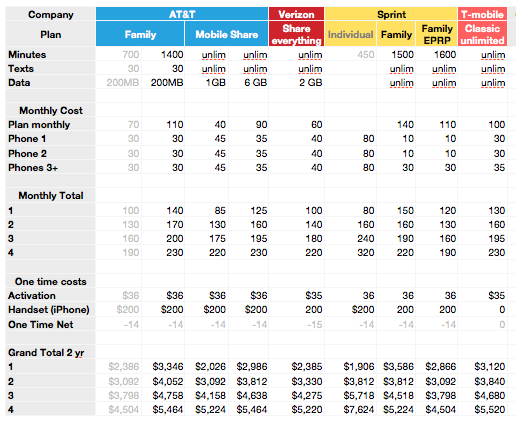I have 4 lines with AT&T and am less than pleased. While data speeds are excellent, any call longer than 20 minutes will drop at least once. Coverage at my house is poor. AT&T’s voice quality is poor and has been for years.
My other major objection is their unlock policy. While AT&T will finally unlock iPhones after their contract is up, that still requires that I keep a 2-year old phone around for international travel. While exploring my options, I put together this TCO (total cost of ownership) comparison chart of the major US carriers (AT&T, Verizon, Sprint, T-Mobile) and a few resellers.
The larger PDF also compares plans from Cricket, Virgin, and Ting. Pricing is shown for each plan with 1, 2, 3, or 4 phones.
Notes:
- The One Time Net value assumes the value of an iPhone 5 in two years is $250. If you purchased an iPhone 4 two years ago, that’s about what your handset is worth today.
- Ting with 3,000 minutes looks outlandish, compared to 1200-1,600 for everyone other plan. That’s because Ting and Virgin have no nights-and-weekends, or mobile-to-mobile. I looked at my past 12-months phone bills to determine how many minutes we’d need.
- An excellent related post, Which iPhone 5 for a Global Traveller


Really awesome price comparison. Our family uses Verizon, but our monthly bill averages about $380 even being grandfathered in with unlimited data from the Moto Q days. I assume our share plan is an outdated one that has higher rates and individual charges for unlimited text and picture messaging which we can’t alter or change without losing the unlimited data option. I just wish I could find a way to make better use of it and tether our iPhones without getting hit with those fees as well.
I am using AT&T and have my family on there with me, I am highly consider Ting. The $6 extra per headset combined with low usage by parents leads me to believe I can get a $350 bill Don to $150 with Ting, my only question is how good is Sprint coverage.
When I used Sprint back in the early 2000’s, coverage was excellent. Looking at online sites and reports like Howard Forums leads me to believe that both Sprint and Verizon still have much more reliable networks in Seattle and Portland. One if the reasons I’m looking at Sprint is that once I’m out of contract at Sprint, I can move one or more lines directly to Ting. A potential downside is that Sprint’s LTE won’t roll out in Seattle until next year some time.
I gave Sprint a try. Coverage is generally good, anywhere from about 3 blocks East of my house to everywhere else in the city I ventured (from downtown to Shoreline). Unfortunately, Sprint’s coverage at my house is even worse than AT&T. Instead of dropping about 5 of every 60 seconds worth of audio, it dropped closer to 15 of most minutes worth of audio.
I called Sprint and explained the problem. The only solution they’d offer is selling me a femtocell. They won’t provide them free to anyone who hasn’t been a customer for at least 90 days. Despite looking at our calling history and seeing our dropped calls. Buying and testing a Sprint femtocell would have put me past the 14 days ‘return without penalty’ window.
I called AT&T, explained the problem, and a technical person looked into it and told me that quite a few AT&T customers near me are using femtocells (supposedly it has to do with us being high on the hill overlooking Puget Sound, and our phones can see ‘too many’ towers). They wouldn’t give me one, but they did credit my account $200, which is how much they sell a femtocell for.
I’ve called AT&T customer service a half dozen times a year, and their service has been nothing short of outstanding. Dealing with Sprint, during the week I used their service, not so much. So I’ve chosen to remain with AT&T, and the femtocell has nicely solved the home coverage problem.